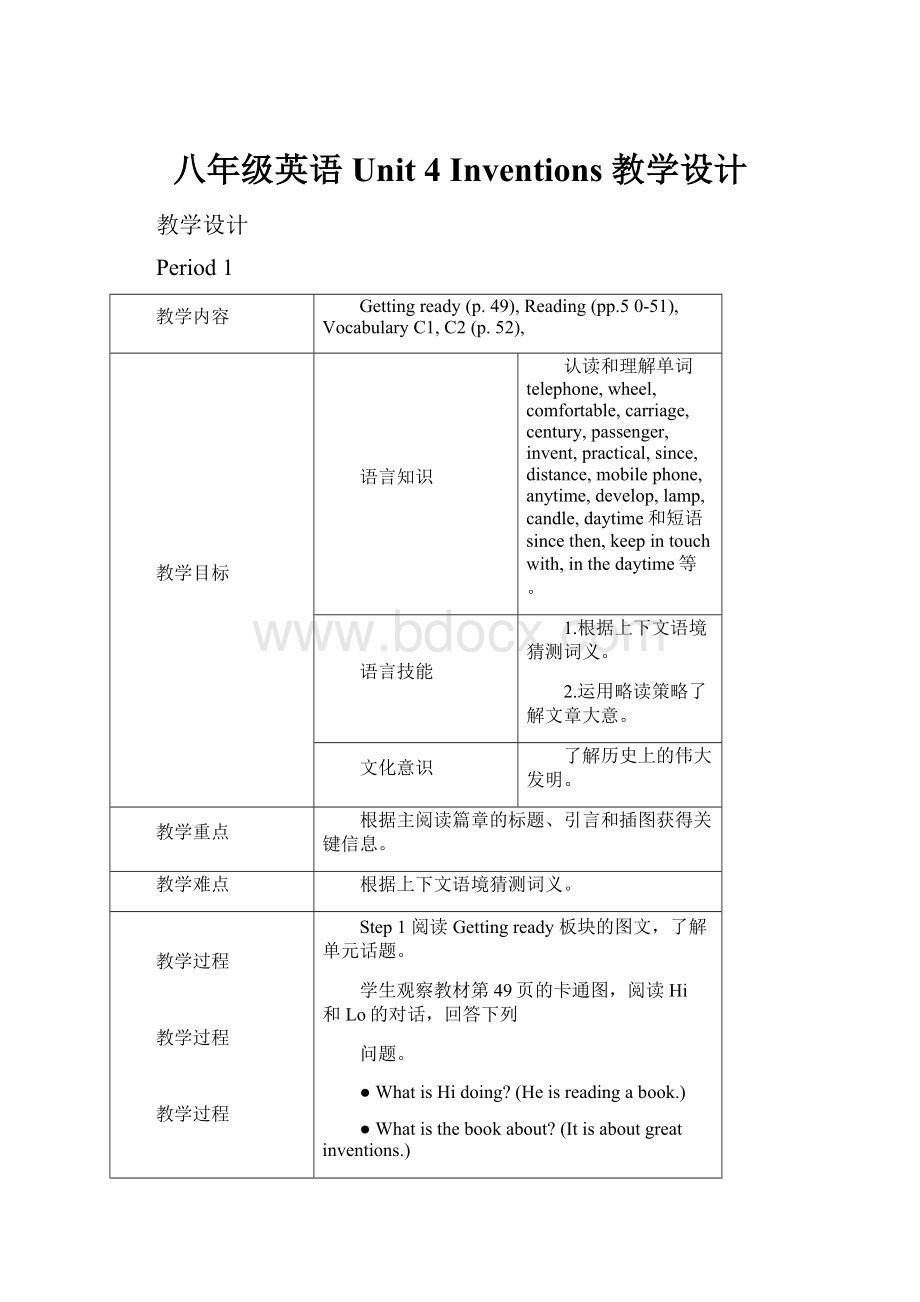八年级英语Unit 4Inventions 教学设计.docx
《八年级英语Unit 4Inventions 教学设计.docx》由会员分享,可在线阅读,更多相关《八年级英语Unit 4Inventions 教学设计.docx(21页珍藏版)》请在冰豆网上搜索。

八年级英语Unit4Inventions教学设计
教学设计
Period1
教学内容
Gettingready(p.49),Reading(pp.50-51),VocabularyC1,C2(p.52),
教学目标
语言知识
认读和理解单词telephone,wheel,comfortable,carriage,century,passenger,invent,practical,since,distance,mobilephone,anytime,develop,lamp,candle,daytime和短语sincethen,keepintouchwith,inthedaytime等。
语言技能
1.根据上下文语境猜测词义。
2.运用略读策略了解文章大意。
文化意识
了解历史上的伟大发明。
教学重点
根据主阅读篇章的标题、引言和插图获得关键信息。
教学难点
根据上下文语境猜测词义。
教学过程
教学过程
教学过程
Step1阅读Gettingready板块的图文,了解单元话题。
学生观察教材第49页的卡通图,阅读Hi和Lo的对话,回答下列
问题。
●WhatisHidoing?
(Heisreadingabook.)
●Whatisthebookabout?
(Itisaboutgreatinventions.)
●WhatdoesHiaskLo?
(Whatisthemostimportantinventioninthe
world?
)
●WhyisLosoproudofhimself?
(BecauseLothinkstherobotisthe
mostimportantinventionintheworldandhehimselfisarobot.)
Step2通过回答问题,激活与单元话题有关的背景知识。
1.学生浏览一组与我们的生活息息相关的重要发明的图片,并回答问题:
Whichisthemostimportantinventiontoyou?
Why?
。
教师帮助学生总结:
Theseinventionshaveallchangedourwayoflifeandmadeourlivesmorecomfortable.。
学生认读和理解单词comfortable。
2.教师展示教材第50页六幅发明的图片,要求学生回答:
Whathavetheseinventionsdoneforus?
(Theyhavegreatlychangedourwayoflife.)。
学生完成练习A1,同时认读和理解单词telephone,mobilephone和wheel。
3.学生小组讨论练习A2的问题:
Howdotheseinventionshelpusinourdailylives?
。
教师帮助学生总结:
Theseinventionshelpusinmanywaysinourdailylives.Wemayusethemanytime,anywhere.Theyareverypractical.。
学生认读和理解单词anytime和practical。
4.学生阅读主阅读篇章中的图片、标题、引言和小标题,回答Beforeyouread部分的两个问题。
5.教师告诉学生:
通过阅读文章图片、标题、引言等信息来了解文章大意的阅读策略叫做略读(skimming)。
学生学习教材第53页Strategy部分的内容,了解略读的概念和作用。
6.学生再次略读全文,尤其关注每一段的首、末句,并回答下列问题。
●Howdogreatinventionshelppeople?
(Theyhelppeoplelivea
betterlife.)
●Whichinventionisprobablythegreatestinhistoryaccordingto
thearticle?
(Thewheel.)
●WhatdidAlexanderGrahamBellinvent?
(Heinventedoneofthe
firstpracticaltelephones.)
●Whenwasthefirstpracticallightbulbinvented?
(In1879.)
Step3通过Vocabulary部分的练习和补充的词汇练习,加深和巩固
核心词汇的理解和运用。
1.学生阅读全文,划出生词。
教师可要求学生通过上下文猜测部分生词的含义或通过VocabularyC1中的句子理解其含义。
2.学生完成VocabularyC2的练习。
3.学生运用本课所学词汇的正确形式,完成补充的词汇练习。
●DaVinciisthemostfamous15thcenturypainter.
●Heopenedthedoorandastrongwindblewoutthecandle/
candles.
●Willpeopleinvent/developnewtypesoftransportationinthe
future?
●Passengerscangetfreewaterattheairport.
●Agoodreportermustkeepintouchwithwhatishappeninginthe
world.
●Couldyouhelpmeandchangetheleftwheelofmycar?
Thetyre
isflat.
●MrGreen’splanwasquitepractical,soeveryoneagreedwith
him.
●HowcanIkeepintouchwithyouifyourmobilephoneisoffall
thetime?
●Astraightlineistheshortestdistancebetweentwopoints.
回家作业
1.抄写单词和短语:
telephone,wheel,comfortable,carriage,century,
passenger,invent,practical,since,distance,mobilephone,anytime,
develop,lamp,candle,daytime,sincethen,keepintouchwith,in
thedaytime等。
2.思考:
Howdothewheel,thetelephoneandthelightbulbhelp
peopleliveabetterlife?
。
3.完成《练习册》第50页Vocabulary和第57页ReadingA的练习。
Period2
教学内容
Reading(p.51),ComprehensionD1,D2,D3(p.53)
教学目标
语言知识
理解和运用短语intheearly19thcentury,beableto,acrosstheworld,allow…todo…,keepintouchwith等。
语言技能
1.能利用所给提示(如图片、关键词等)描述一件发明。
2.能通过图表理清文章结构,归纳文章大意。
文化意识
深入了解伟大发明如何改变人类的活动。
教学重点
掌握主阅读篇章的事实信息,巩固核心单词和短语。
教学难点
运用图表理清文章的结构和主要内容。
教学过程
Step1了解更多的发明,同时复习第一课时所学的词汇。
学生根据提示信息,说出各项发明的名称。
●Wecanuseittocommunicatewithpeopleoverlongdistance.(telephone/mobilephone)
●Wecanmakephonecallswithitanytime,anywhere.(mobilephone)
●Itisperhapsoneofthemostpracticalinventionsinthe20thcentury.Nowpeopleuseitforbothworkandplay.(computer)
●Afteritsinvention,wenolongerneededtousethestairs.(lift)
●Itcoolsorwarmsroomstomakethemmorecomfortableforpeopletostayin.(airconditioner)
●Passengerswhousethisfortransportationnolongerneedtoworryabouttrafficjams.(theunderground)
●TheWrightbrothersinventedthefirstmachine-poweredmodelofit.(airplane/aircraft)
Step2通过图表理清主阅读篇章结构,归纳文章主要内容。
1.学生阅读主阅读篇章的第一部分,并填写下表。
Thewheel
Inventor
Don’tknow.
Timeofinvention
Afewthousandyearsago.
Lifeafteritsinvention
Travellingbecamefasterandmorecomfortable.
Examples:
●carriages
●trains
●cars
2.学生阅读主阅读篇章的第二部分,并填写下表。
Thetelephone
Inventor
AlexanderGrahamBell.
Timeofinvention
In1876.
Lifeafteritsinvention
●Peoplecanspeaktoeachotheroverlongdistances.
●Peoplecankeepintouchwitheachotheranytime,anywherewithmobilephones.
3.学生阅读主阅读篇章的第三部分,回答下列问题。
●Whatdidpeopleusetoseeatnightbeforetheinventionofthe
lightbulb?
(Peopleusedoillamps,gaslampsorcandles.)
●Whathasthelifebeenlikeaftertheinventionofthelightbulb?
(Peoplecandoasmanythingsintheeveningsastheycaninthe
daytime.)
4.教师播放课文录音,学生跟读课文。
教师根据学生的实际情况和教学需要,讲解课文中的知识点。
学生认读和理解短语intheearly19thcentury,beableto,acrosstheworld,allow…todo…,keepintouchwith;认识专有名词AlexanderGrahamBell和ThomasEdison。
Step3根据主阅读篇章的内容,运用所学词汇描述电脑这项伟大发明。
1.学生完成ComprehensionD1,D2的练习,加深对主阅读篇章细节
信息的理解。
2.学生模仿主阅读篇章内容,谈论电脑这项伟大发明。
教师可提供一些关于电脑的信息、开头和结尾句型以及描述中可能会用到的词汇。
Step4讨论和回答问题,进一步理解“发明改变生活”的话题。
学生分组讨论和回答ComprehensionD3中的问题,并陈述自己的观点。
回家作业
1.模仿录音的语音、语调,朗读课文。
2.复习主阅读篇章中的词汇。
3.从以下话题中任选一个进行思考并作口头准备,然后在下一课时
口头汇报。
●Imaginelifewithoutwheels
●Imaginelifewithouttelephones
●Imaginelifewithoutlightbulbs
4.完成《练习册》第58至59页ReadingB,C的练习。
Period3
教学内容
Grammar(pp.55-57)
教学目标
语言知识
1.学习形容词good,bad和far的不规则比较级和最高级的形式及用法。
2.学习as…as结构及其用法。
语言技能
能根据所给的图表信息,运用所学语法知识,比较事物。
学习策略
自主归纳语法规则的能力和交流过程中的合作精神。
教学重点
运用形容词good,bad和far的不规则比较级和最高级以及(not)as…as结构比较事物。
教学难点
运用(not)as…as结构比较事物。
教学过程
教学过程
教学过程
教学过程
Step1检查回家作业的落实情况。
学生口头汇报一下内容。
●Imaginelifewithoutwheels
●Imaginelifewithouttelephones
●Imaginelifewithoutlightbulbs
Step2学习形容词good,bad和far的不规则比较级和最高级形式,并初步运用。
1.教师告诉学生:
Weshouldbethankfultotheinventorsfortheirgreatinventions.Wecanlearnalotfromthem.。
学生读以下这段名言,体会发明家不断追求完美、永不放弃的精神。
Good,better,best.Neverletitrest.Untilyourgoodisbetterandyourbetterisbest.
2.教师由这段名言引出教材第55页常用的三个形容词good,bad和far的不规则比较级和最高级的形式。
3.学生观察练习A1中的成绩表。
为了确保学生理解表格中的数字。
教师可以提问:
Whatdoesthenumber“83”mean?
(Daisygotan83inArt./Daisy’smarkinArt.)
4.学生观察练习A1的示例,教师可以通过以下问题确认学生理解示例中分别使用比较级和最高级的原因。
Whydoweuse“better”inthefirstexamplebut“best”inthesecond?
(Inthefirstexample,wecomparetwostudents’marks.Inthesecondexample,wecomparemorethantwostudents’marks.)
5.学生完成练习A1,通过对子活动核对答案,并朗读对话。
6.学生完成练习A2。
然后,教师可要求学生改变参照地点编制对话,进一步巩固far的比较级和最高级的用法。
如:
S1:
Whosehomeisfarther/furtherfromAlice’s,Daisy’sorPaul’s?
S2:
Paul’shomeisfarther/furtherfromAlice’s.
S1:
Whosehomeisthefarthest/furthestfromAlice’s,Daisy’s,
Paul’sorEric’s?
S2:
Eric’shomeisthefarthest/furthestfromAlice’s.
7.教师要求学生说出他们所知道的其他常见的比较级和最高级是不规则变化的形容词,并帮助学生总结出以下三个表示数量的形容词。
同时提醒学生few是规则变化。
学生用这些词的比较级完成句子。
many-more-themostmuch-more-themost
little-less-theleastfew-fewer-thefewest
●Withlightbulbs,peoplecandomorethingsthanbeforeatnight.
●Lightbulbsproducemorelightthanoillamps.
●Oillampsproducelesslightthanlightbulbs.
●Carriagescarryfewerpassengersthantrains.
8.学生根据下表,用many,much,little和few的比较级和最高级形
式完成句子。
教师应提醒学生注意表中的可数名词与不可数名词。
Student
Thingsthestudenthas
Alice
30storybooks,7notebooks
3packetsofpaper,5bottlesofink
Ben
27storybooks,8notebooks
2packetsofpaper,8bottlesofink
Judy
21storybooks,12notebooks
1packetsofpaper,6bottlesofink
Example:
BenhasmorepaperthanJudybutfewerstorybooksthanAlice.
●JudyhasfewerstorybooksthanAlicebutmorenotebooksthanBen.
●BenhasmoreinkthanJudybutlesspaperthanAlice.
●Alicehasthemoststorybooksamong/ofthethreestudents.
●Judyhastheleastpaperamong/ofthethreestudents.
●Alicehasthefewestnotebooksamong/ofthethreestudents.
●Benhasthemostinkamong/ofthethreestudents.
Step3学习同级比较结构as…as及其用法。
1.教师提问:
Howbigwasthefirstcomputerintheworld?
(Itwasbiggerthanacar.)。
然后向学生展示第一台计算机的图片,告诉学生:
Thefirstcomputerwasasbigasroom.。
学生找出主阅读篇章中含有as…as结构的句子。
如:
Withlightbulbs,peoplecandoasmanythingsintheeveningsastheycaninthedaytime.。
2.学生观察教材第56页的例句,完成Workouttherule部分的内容。
3.学生完成练习B1。
教师注意让学生理解产品说明中H,W,D分别代表高(Height)、长(Width)和宽(Depth)。
4.学生完成练习B2。
教师提醒学生注意表中的可数名词与不可数名词。
5.学生根据下表与示例,用(not)as…as结构完成句子。
Student
Thingsthestudenthas
Lucy
25storybooks,2notebooks
5packetsofpaper,1bottleofink
Mary
25storybooks,2notebooks
5packetsofpaper,1bottleofink
Sandy
32storybooks,4notebooks
2packetsofpaper,5bottlesofink
Example:
LucyhasasmanystorybooksasMary.
Marydoesn’thaveasmanystorybooksasSandy.
●LucyhasasmuchpaperasMary.
●LucyhasasmuchinkasMary.
●Mary/Lucydoesn’thaveasmanynotebooksasSandy.
●Sandydoesn’thaveasmuchpaperasMary/Lucy.
●Mary/Lucydoesn’thaveasmuchinkasSandy.
●MaryhasaslittleinkasLucy.
●LucyhasasfewnotebooksasMary.
回家作业
1.调查并比较班级同学的不同方面,如身高、体重等。
要求在比较中运用形容词good,bad,far,many,much和little等的比较级和最高级以及(not)as…as结构。
2.完成《练习册》第51至53页Grammar的练习。
Period4
教学内容
Speaking(pp.58-59),Project(pp.63-64)
教学目标
语言知识
1.掌握朗读一般疑问句时的语调。
2.了解发明在日常生活中的应用和中国古代四大发明。
语言技能
1.在一般疑问句的句尾使用升调。
2.根据提纲和范文,合作撰写关于中国古代四大发明之一的短文。
情感态度
在对话和完成课题的过程中积极与他人合作,互相帮助,共同完成任务。
教学重点
运用问答形式谈论生活中常用的发明。
教学难点
小组合作查找资料,并撰写一篇关于中国古代四大发明之一的短文。
教学过程
教学过程
Step1学习Talktime部分朗读一般疑问句时的语调。
1.教师通过提问方式和学生进行交流。
如:
CanIaskyousomequestions?
Doyoure